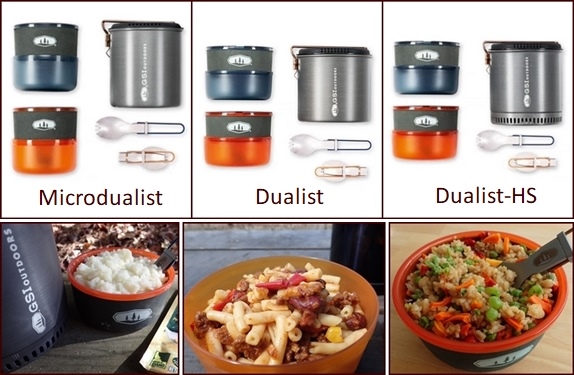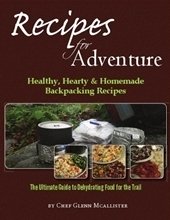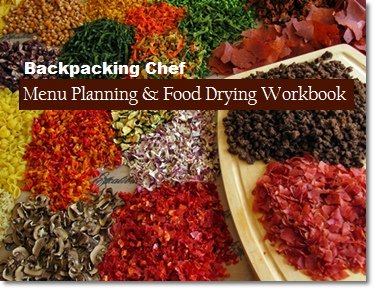Which GSI Dualist Cookset is Best for Two People?
GSI Dualist cooksets come in three configurations. In this review, I compare the Microdualist, Dualist, and Dualist-HS pots, and demonstrate “easy-clean” bowl cooking.
Photo: Meals cooked in GSI cookset bowls.
Since the bowls are one of the key features of these GSI cooksets, I’ll start with them and follow with a comparison of the pots.
Table of Contents
GSI Dualist Easy-Clean Bowl Cooking
GSI Microdualist & Dualist Cookset Accessories
Cooking Breakfast, Lunch & Dinner in GSI Bowls
GSI Dualist Easy-Clean Bowl Cooking
If you find cleaning a pot that you cooked a meal in to be a pain, but you’re also not wild about eating meals out of freezer bags, then bowl cooking could be for you.
Just boil water in the GSI Dualist pot and add it to the dried ingredients in the bowl.
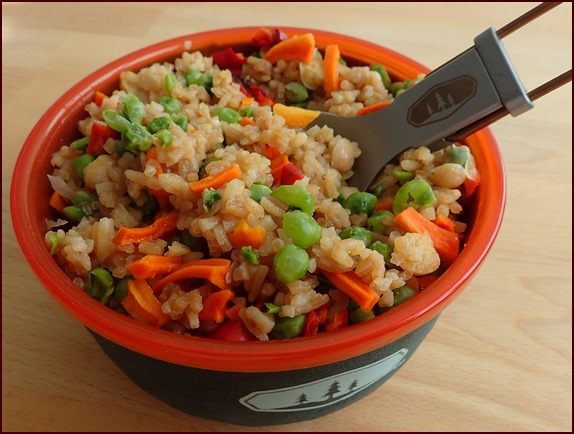
Photo: Fried Rice & Vegetables rehydrated in
GSI Dualist 20-oz. bowl. Here's the recipe.
Cleanup is as easy as 1-2-3!

1. Round up every morsel of your delicious meal with the spoon.
2. Swirl a little water around the bowl and drink it.
3. Wipe the bowl clean with a ¼-sheet of a paper towel.
GSI Microdualist & Dualist Cookset Accessories
The GSI Microdualist and Dualist cooksets come with two cups and two bowls, plus two lids and two insulating sleeves.
The insulating sleeves and lids hold in the heat while meals rehydrate, and they also make the bowls & cups comfortable to hold while eating and drinking. Each cup/bowl set nests together when packed inside the pot.
If you're already set with a backpacking pot, you can still order the GSI Bowl sets by themselves. See sources at bottom of page.
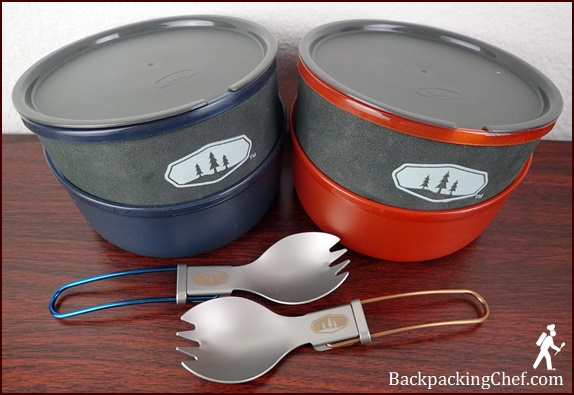
Photo: 20-oz. bowls/cups, lids, insulating sleeves, and folding spoons included with GSI Dualist Cooksets.
The cooksets include two metal folding spoons.
The pot lids are made of sturdy plastic with strainer holes.
The Microdualist and Dualist Cooksets also come with a “kitchen sink,” which encloses the pot when packed. The water-tight sink is useful for taking sponge baths, as well as for cleaning up the cookware.
Cup & Bowl Capacities
- GSI Microdualist = 14 oz. each.
- GSI Dualist & Dualist-HS = 20 oz. each.
With the Microdualist cookset, you can cook “regular-size” dehydrated meals in the bowls as long as you don’t go over 1¼ cups of dried food combined with 1½ cups of water.
With either of the GSI Dualist cooksets, you can cook large dehydrated meals in the bowls which could go up to 1¾ cups of dried food combined with 2 cups of water.
In Recipes for Adventure: Healthy, Hearty & Homemade Backpacking Recipes, I give both regular and large serving sizes for all recipes.
Packability
With the taller and narrower GSI Microdualist pot, you can pack all four 14-oz. bowls/cups along with a 110 gram fuel canister, stove, and folding spoons. You can still carry a larger 230 gram fuel canister, but with that setup you can only fit two of the bowl/cups inside the pot with the rest of the gear.
With the wider GSI Dualist pots, you can pack all four 20-oz. bowls/cups inside the pots with a 230 gram fuel canister, stove, and folding spoons.
Cooking Meals in GSI Dualist Bowls
Breakfast
Pots can be difficult to clean when oatmeal is cooked in them. But all it takes is a few swirls of water and a quick wipe with a piece of paper towel to clean up oatmeal that is cooked in GSI bowls.
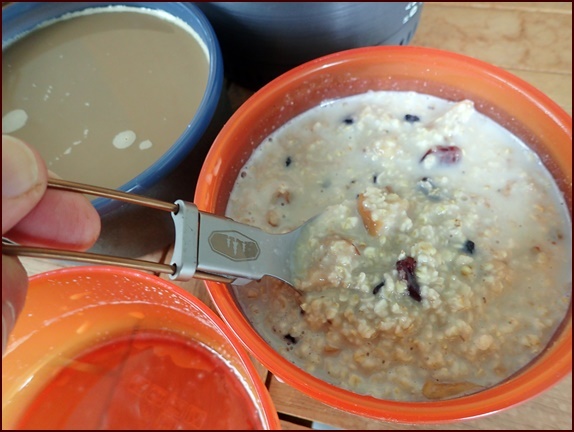
Dominique and I enjoy oatmeal and coffee as one of our backpacking breakfasts. With the GSI Dualist Cookset, I add heated water to dried fruits and oats in the bowls. It takes just a few minutes until breakfast is served.
In one of the free cups, I mix up powdered milk and pour some of it into Dominique’s coffee and the rest over our oatmeal. Then I use the milk cup for my black coffee. The lids have sippy holes, so our coffee stays hot. We use instant coffee on the trail. The cups and bowls are also handy if we just want coffee and a no-cook breakfast of granola with milk. Explore: Homemade Granola Recipes.
Grits are another breakfast food that can be difficult to clean up when cooked in a pot, but it’s no problem with bowl cooking.
Lunch
Dominique and I prepare hot lunches in the morning by adding boiled water to the dried ingredients in a thermos food jar. GSI bowls are handy for dividing the meal wherever we stop for lunch. Explore: Thermos Cooking.
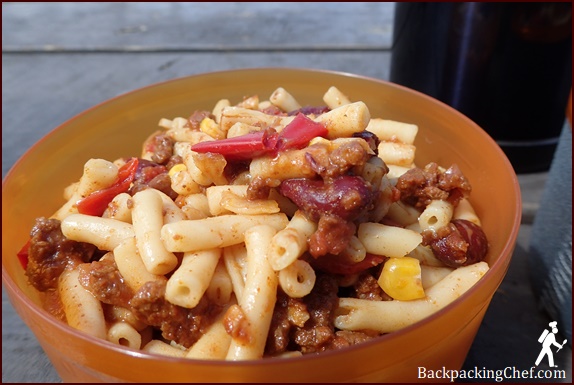
Photo: A serving of chili mac rehydrated in a thermos food jar and served in a GSI Microdualist bowl. Here’s the chili mac recipe.
Dinner
It only takes two bowls to make dinner for two, but you have the extra cups if you want to enjoy hot or cold drinks on the side.
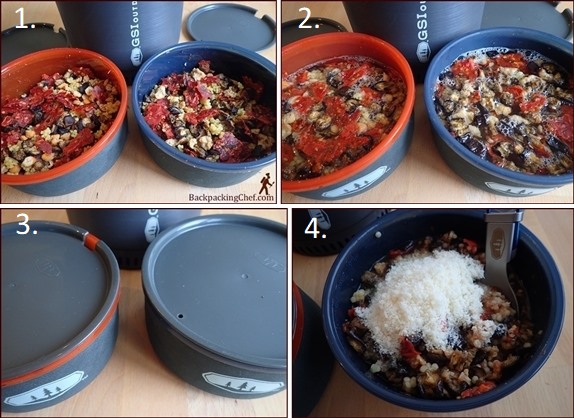
Photo: Making eggplant parmesan in 20-oz. bowls. Here’s the recipe.
1. Place dried ingredients in bowls.
2. Add heated water and stir. GSI bowls are rated up to 100°C (boiling point). Allow boiled water to cool for a few seconds before adding to bowl, or turn off the stove just before the water reaches a boil.
3. Place lids on bowls and wait 20–25 minutes until water is mostly absorbed by food.
4. Stir in olive oil or powdered ingredients, such as parmesan cheese. Buon appetito!
Cooking Pasta in a GSI Dualist-HS Pot
If you precook and dehydrate pasta as part of your backpacking meals, then the pasta will rehydrate easily with boiled water with no additional cooking time needed. You can even rehydrate it with cold water if you give it a longer soak time. Explore: Cold Soak Salad Recipes.
But in cases where you resupply at a store during a longer backpacking trip, you may want to buy meals like boxed macaroni and cheese that you can add a packet of tuna or chicken to.
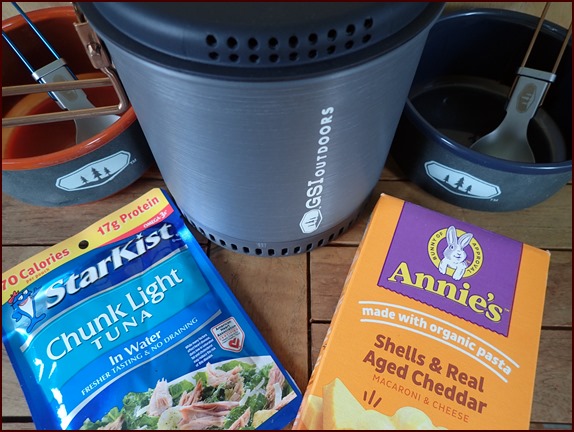
Pasta from the box has to be cooked with more water that needs to be held at a boil for several minutes, but you can get away with cooking it on the trail with much less water than you would use at home.
Tuna Mac & Cheese
Servings: 2
Ingredients:
- 1 box of mac & cheese (1¼ cups, 142 g)
- 1 packet of tuna, salmon, or chicken (75 g)
- 2½
cups water (600 ml)
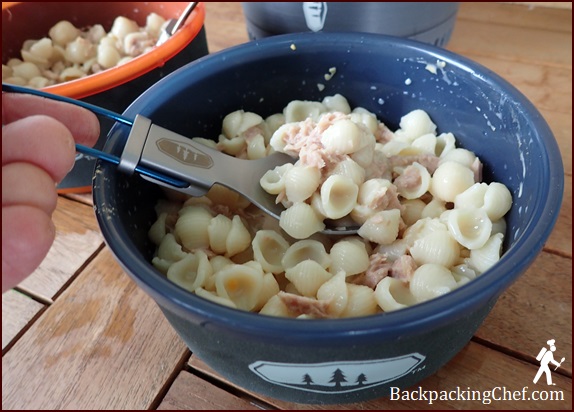
On the Trail:
- Put pasta, pinch of salt, and water in GSI Dualist pot, and light stove.
- Bring to a boil. (Water will reach a boil in approx. 2 minutes, 30 seconds)
- Once a boil is reached, continue cooking with the lid off the pot or it may boil over. Lower the output of the stove to maintain a simmer.
- After about 3 minutes of boil/simmer time, take the pot off the stove and place the lid back on.
- Wait another 10 minutes, then pour off the water into one of the extra GSI cups.*
- Divide the macaroni into 2 bowls, stir in the cheese powder, then top with meat from packet.
* I don’t pour off pasta water on the ground around campsites. It draws flies and leaves a residual odor that may attract varmints. You’ll find that if you pour off the pasta water into a cup, it’s pretty tasty. With a pinch of bouillon, it’s like having a cup of soup with your meal.
Cooking Mashed Potatoes in a GSI Bowl
Making a side of mashed potatoes couldn’t be easier than with a GSI bowl. In the other bowl, you could rehydrate a serving of chili or dehydrated soup, and have a 2-course meal.
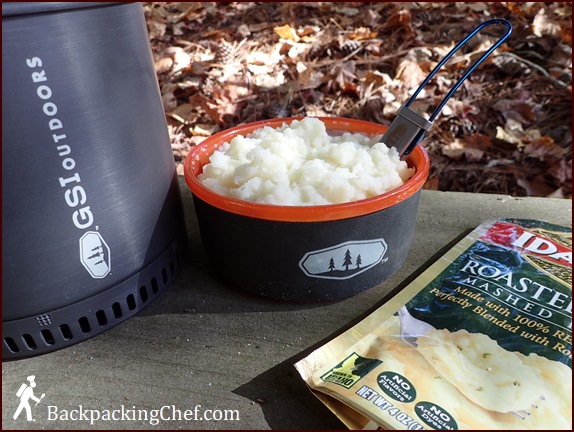
Photo: One package of Idahoan brand mashed potatoes prepared in a GSI 20-oz. bowl.
Although you can make homemade mashed potato powder, many backpackers opt for the store-bought variety. A 4-oz. (113 g) package of Idahoan mashed potatoes is listed as four servings, but really… two hungry hikers can easily polish it off.
Shop Amazon: Idahoan Instant Mashed Potatoes.
Per the directions on the package, add two cups of boiled water to the bowl. Allow the water to cool slightly before adding it to the bowl. Pour in the instant mashed potatoes and stir. Potatoes are ready instantly, so you will want to rehydrate your other side of chili or stew first.
You can prepare the whole package of instant mashed potatoes in one of the 20-oz. bowls that come with either of the GSI Dualist 1.8 liter pots. If you are using one of the 14-oz. bowls that come with the GSI Microdualist 1.4 liter pot, you can prepare the mashed potatoes using two bowls.
Dessert
Last but not least, GSI Dualist bowls are great for making hot or cold trail desserts, like fruit puddings and applesauce.
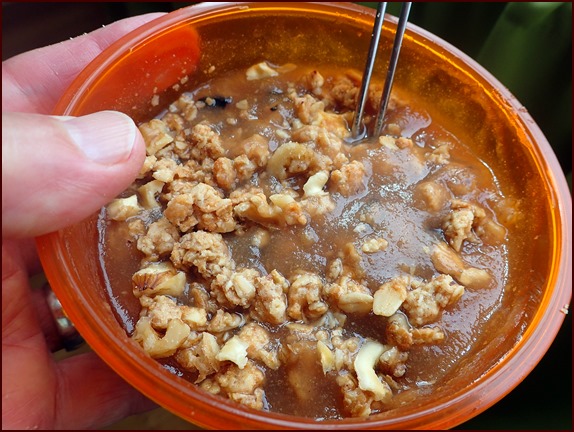
Photo: Blueberry Crunch Pear Pudding
In the photo above, I rehydrated pear fruit leather and dried blueberries with cold water, and topped that with chopped walnuts and granola. Here’s the recipe.
Comparing GSI Dualist & Microdualist Pots
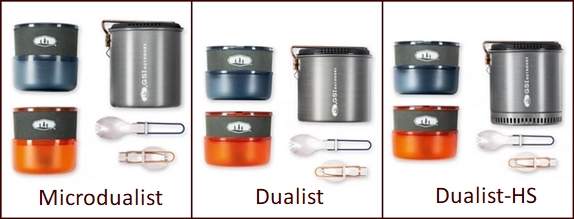
Photo: GSI Cooksets for two people.
The 1.4 liter GSI Microdualist pot is a little taller and narrower than the two 1.8 liter Dualist pots. The Dualist-HS pot has the same capacity as the Dualist, but is 1-inch taller to accommodate the heat sink bottom.
The specifications for the GSI cooksets in the chart below are for the full kits including all accessories.
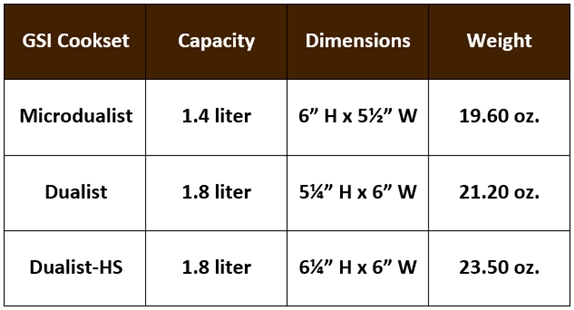
Material
Halulite: GSI’s brand of hard anodized aluminum without a nonstick coating. A nonstick coating is not needed for boiling water or rehydrating dehydrated meals.
Hard anodized aluminum pots are sturdier than thinner titanium pots, but they are heavier than similar-sized titanium pots.
Hard anodized aluminum conducts heat evenly and faster than titanium.
Handles
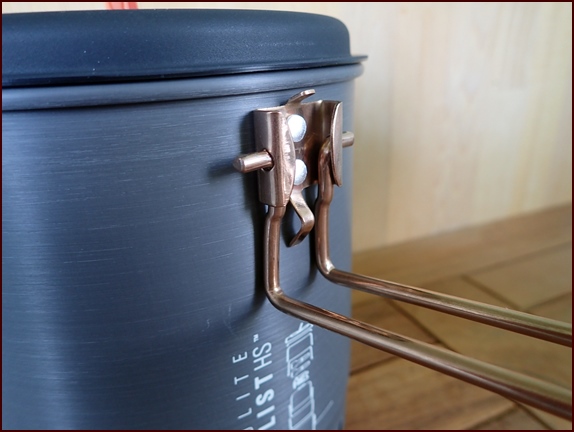
Handles lock over the lids when stowed. Although the handles are not insulated, they do not get hot when you boil water on a backpacking stove.
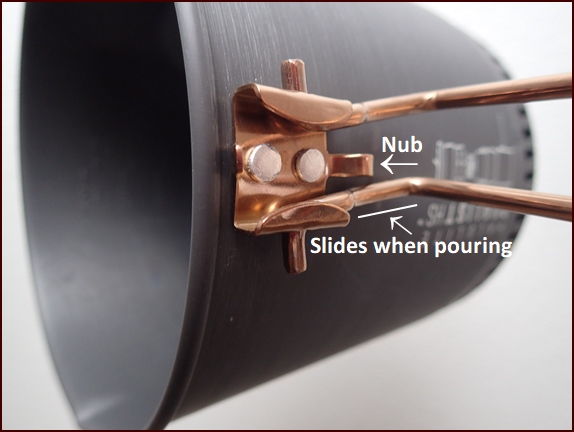
The handles are sturdy, but when you tilt the pot to pour water, the left bar of the handle slides about a ¼-inch at an angle until it catches on the nub as shown in the photo above. To confirm this little shift was not a safety issue, I shook the pots aggressively at all pouring angles.
Time to Boil
I tested the boil times of the Microdualist pot and the Dualist-HS pot using a GSI canister stove and GSI windscreen. Boil times, of course, will vary depending on the starting temperature of the water and the weather conditions.
Overall, water boils very fast in these Halulite hard-anodized aluminum pots, especially in the GSI Dualist-HS with the heat sink pot bottom.
(Minutes: Seconds)
Microdualist
- ½ liter: 2:45
- 1 liter: 4:30
Dualist-HS
- ½ liter: 2:30
- 1 liter: 2:45
- 1.4 liters (48 oz.) 3:30
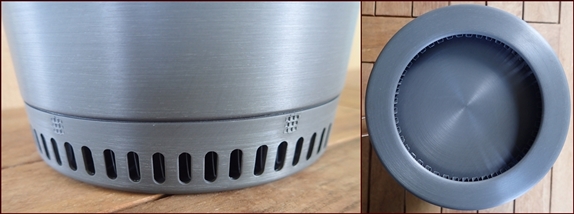
Photo: Heat sink bottom of the GSI Dualist-HS pot. Metal fins hold more heat against the pot and reduce wind.
The GSI Dualist-HS, with its 1.8 liter capacity and heat sink bottom, would be an excellent choice for winter camping where you might need to melt snow, or where you are starting out with very cold water.
GSI Cooksets Pros & Cons
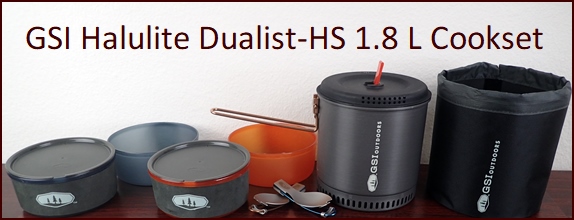
Pros
The bowls and cups with lids and insulating sleeves allow you to rehydrate dehydrated meals in the bowls—cleanup is super easy.
Halulite hard-anodized aluminum pots, while heavier than titanium pots, are sturdy and conduct heat evenly for fast boil times.
All the cookset components nest inside the pot, along with a fuel canister and canister stove. The pot stows inside the kitchen sink, which is useful for personal hygiene as well as for cleaning the cooking gear.
A GSI windscreen can be wrapped around the pot, and the windscreen plate can be stowed under the pot, all inside the kitchen sink stow bag.
The GSI Dualist-HS pot with heat sink bottom saves fuel, extending your range.
Two adults and two children, or even four adults, could eat well using four 20-oz. bowls/cups in the 1.8 liter Dualist cooksets.
Cons
The 1.8 liter Dualist cooksets are heavier than smaller pot kits, but the ease of cooking in the 20-oz. bowls will make the kit “worth the weight” for many backpacking partners, especially when the pots are used in car camping and canoe camping situations where weight is less of a concern.
The 14-oz. bowls and cups in the GSI Microdualist cookset are ok for rehydrating smaller meals in the bowls, but larger meals are better accommodated in the Dualist 20-oz. bowls and cups.
The metal folding spoons (sporks) are heavier than the plastic spoons previously used in GSI cooksets, but they won’t break, and they feel good in the hand and mouth.
Conclusion
The bowls and cups included in the GSI Dualist cooksets, with lids and insulating sleeves, make “easy-clean” bowl cooking an attractive option for backpackers who don’t want to clean up a pot or eat out of a bag.
Instead of packing dehydrated meals in liter-size Ziploc bags for “freezer bag cooking,” meals can be packed in smaller sandwich-size Ziploc bags.
The larger 1.8 liter Dualist cooksets offer more meal preparation versatility with the 20-oz. bowls compared to the 1.4 liter Microdualist cookset with the smaller 14-oz. bowls.
The heaviest of the three GSI cooksets is the Dualist-HS, but for the extra 2.3 ounces compared to the Dualist without the heat sink bottom, you get faster boil times using less fuel.
Where to Buy

Buy direct from GSI Outdoors:
Buy from Amazon:
Disclosure: As a GSI Outdoors and Amazon Associate, Backpacking Chef earns from qualifying purchases. Thank you!
Explore More…
GSI Minimalist Backpacking Pot Review
Share this page with friends on social media.
Free E-book & Newsletter
Free with Trail Bytes subscription.
Dehydrating Food from A–Z

